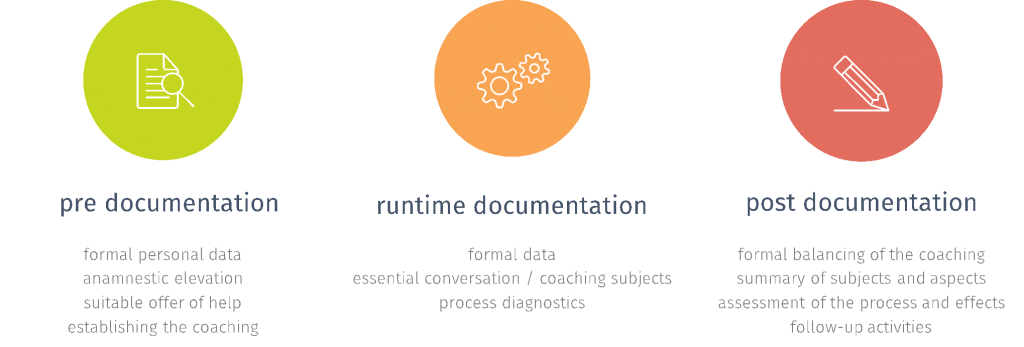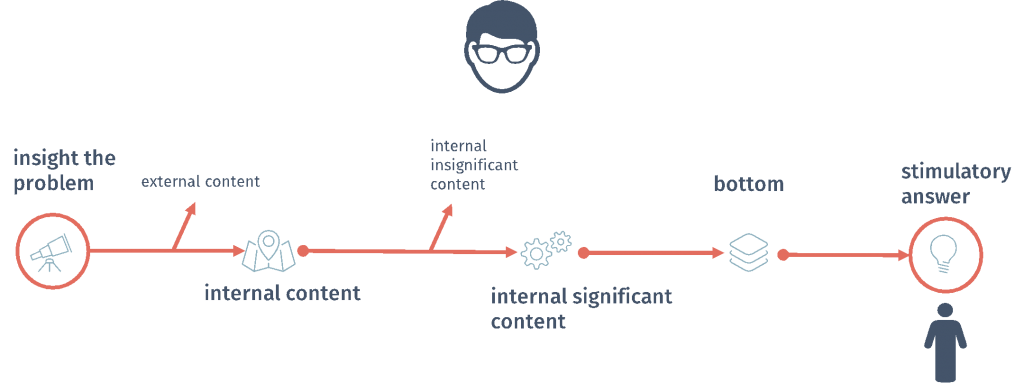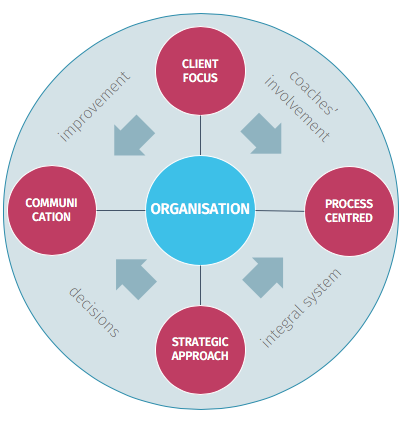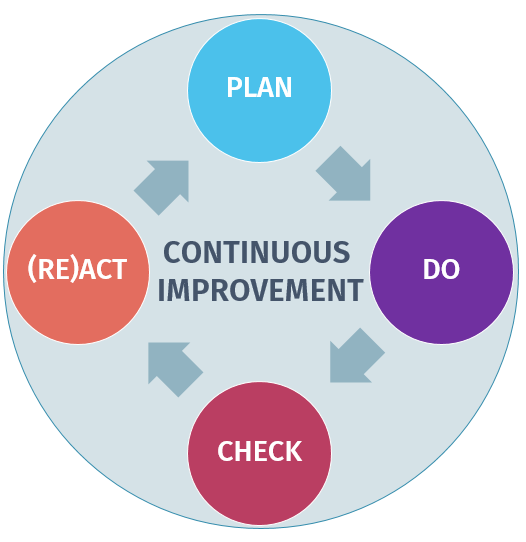Quality Management
Intro
After the introduction of a new approach in education (INTENSE) – the approach has proved to be effective, delivering results that are better compared with previous methods and it must be guaranteed for the future.
Therefore every project that intends to change teaching and coaching practice needs a quality program.
Quality policy (definitions)
- Everything the institution wants to do in the coming years to provide good quality and improve that quality.
- Descriptions of the objectives in terms of quality, quality level, and paths that should lead to it.
- The objectives of an institution with regard to quality, as well as the ways and means which lead to the attainment of these objectives. These should be formally reflected in a management statement.
Quality control (definitions)
- That part of the quality management that focuses on meeting the quality requirements.
- Testing the quality standards of a product or service.
Quality assurance (definitions)
- All activities of the overall management function that determine the quality policy, objectives and responsibilities and implement it through quality planning, quality control, quality assurance and quality improvement within the quality system.
- Quality assurance can be defined as “the control of a process of continuous improvement in order to meet the quality requirements”. This always concerns the relationship between its own goals and aspirations, securing them in policy, management and processes and how the results relate to the goals.
From quality control to quality assurance
Quality control and quality assurance are two concepts that play an important role in the context of quality of education. Quality control implies the checks afterwards whether the desired quality is achieved.
By quality assurance we do not only look at the results of the pupils or students, but we look in particular whether all conditions are met in order to achieve good results, so we also look at the learning process, to the support, to the facilities, materials and tests. Unlike quality control that leads to corrective actions, quality assurance focuses on prevention, preventing poor quality products are delivered.
source: Total Quality Management and Operational Excellence. Author: John S. Oakland. Publisher: Taylor & Francis Ltd. Paperback 9780415635509 April 2014
Video-Link: https://youtu.be/TKaHZPrJW2k
Process quality assurance
As the term “coaching” may embrace a huge variety of meanings to everyone who regards him- or herself a “coach”, it is of utmost importance to define a clear coaching procedure that fits our purpose. In order to justify its means as well as to deliver a certain standard of quality in what we do, we shall implement a neat system of quality assurance. By quality assurance, we mean a standardized and operational procedure that will ensure the efficiency of coaching and make the coaching process verifiable.
In the following we set out to present a structural framework with individual steps for quality assurance in coaching situations.

| 1 | pre-documentation |
| 1-1 |
|
| 1-2 |
|
| 1-3 |
|
| 1-4 |
|
After the anamnesis, it is up to the coach in charge to decide about the next steps for the client and whether at this point of the process the coach is the right person address the client’s needs. It could be the case, for example, that a referral to a detox-centre will be most helpful for the client first, before the coach can start with non-directive interventions.
At the start of the coaching, the coach will explain his or her methodical approach to the client so that he or she can decide if the methodology suggested is suitable at this particular point. Perhaps it is more helpful for the client to balance the interventions pursued and focus on communicative support first, before the client is able to understand further targets.
After a decision on the right strategy of support and the specific offer of assistance has been made, the client will set his or her individual targets with the help of the coach.
Do not forget to inform your coachee about what you mean by using a client-centred and non-directive approach – tell him or her what you do, what you do not do, and why you do it!
The coach will also have to take notes about the essential subjects of every coaching session. It is important to minute the behaviour of the client, the coach’s interventions, and the aspects of the relationship structure between the coach and the coachee, as well as the agreements made during the coaching session. Of course, the particular problems discussed and the changes in relation to the problems and circumstances in the client’s life have to find their way into the minutes as well. Please bear in mind that these meeting notes are strictly confidential, which means that they are only to be shared by the coach and the coachee.
| 2 | documentation throughout the coaching period (runtime) |
| 2-1 |
|
| 2-2 |
|
| 2-3 |
|
It is appropriate to use standardized questionnaires after every coaching session to assure the quality of the coaching throughout the process. Therefore, it is necessary to use two types of questionnaires – one for the client and a one for the coach.
Important aspects to know from the client’s perspective are:
- how he or she is coping with the coach and him or herself during the coaching unit,
- how the coachee experiences changes of attitudes, pints of view, and/or behaviour throughout the coaching,
- how secure and confident the coachee feels on a personal level, and
- how the coachee feels how good he or she can calm down.
Fundamental issues from the coach’s point of view are the perceived interaction and changes of the client. For a proper analysis, it may be insightful to compare both perspectives in general, as well as each single item.
It is also possible to rate the client’s self-exploration as well as in how far the coach’s conversational behaviour follows the defined values of the client centred approach.
Comparable to how evaluations are usually made after processes and projects, the client centred coaching process will be followed by a clear-cut post documentation. The following information is to be documented:
- hard facts of the coaching
- summary of essential conversation subjects and aspects of the coaching process
- subjective assessment of coaching effects and
- suggestion for follow-up activities
Therefore, it is recommended to use a standardised questionnaire. The following table shows important structural aspects for the post documentation.
| 3 | post documentation |
| 3-1 |
|
| 3-2 |
|
| 3-3 |
|
| 3-4 |
|
Supervision
If we are talking about supervision in psychosocial work environment, we recognize it as a fundamental method of quality assurance. A supervisor and the other participants of a work group look with an appropriate distance on a problem described by a coach.
In relation with the client-centred coaching, the supervision will support the personal development of the coach. By using the “client-centred supervision” in the professional context, the coach will be helped to understand him/her self and the relation to the client better. In this way, he/she is able to develop action alternatives on the base of his/her own potential.
If we face the term “professional context”, it is also clear that we will make the organisational and structural aspects a subject of supervision. To get a clear picture what does it mean to supervise a client-centred coaching, we would like to cite an example of a stagnant self-exploration of the client.
The major task of the coach is to get the bottom of client’s problem (together with the client) and inspire and stimulate client’s self-exploration in the coaching session, that follows the principles of non-directive communication.
To get an insight of an undifferentiated content it is necessary to distinguish between external and internal, further on between internal significant and insignificant content to get the bottom of the clients problem and formulate stimulatory answers, that the client can go on to reach all the grades of his/her self-exploration.

Supervisor’s role is to take the position, which allows him the metacognition of the process in a reflective supervisor-coach conversation.
Throughout the reflection, the supervisor will illuminate every subsequent step of the process to get the bottom of the problem and in parallel the grades of client’s self-exploration that come along with it.
Major question in that context is: Did the coach focus on the internal content that is significant to get the bottom and stimulate the client in his/her Self-exploration proceeding?

With this kind of process reflection, the supervisor is decoding the actions of the coach and gives feedback whether the coach took an early gateway or can’t find the expected stimulatory answer to encourage the client in his/her self-exploration (see also self-exploration).
source:
S. Weinberger, Klientenzentrierte Gesprächsführung, 14. Auflage 2013, Weinberg und Basel, S. 145 ff.
The European Mentoring & Coaching Council developed guidelines for supervision – here. If you want to read more about EMCC developed standard of supervision, please click here.
Total Quality Management
 TQM, also called Integrated Quality Assurance is an extensive and structured approach to organizational management focusing on continuous improvement of product and service quality based on continuous feedback.
TQM, also called Integrated Quality Assurance is an extensive and structured approach to organizational management focusing on continuous improvement of product and service quality based on continuous feedback.
Besides William Edwards Deming, Joseph Juran is also one of the founders of Total Quality Management.
Total Quality Management is used primarily in business, but can also be used very well in the non-profit sector, provided that a number of terms are changed. The product stands for the educational goal to be achieved and the customers are students and / or teachers.
Customisable
It is of utmost importance to realize that customers always determine the level of quality. Regardless of what efforts are being made in the field of staff training or improvement of processes, the customer ultimately determines, for example, whether the measurement of satisfaction or the efforts made have helped to continuously improve product and service quality.
Processes are central
Process thinking and processual handling is part of the foundation of TQM. Processes are leading and systems and people support these processes based on the goals that are linked to the mission, vision and strategy.
Decisions based on facts
Decision-making within the organization takes place only on the basis of facts and not on the basis of opinions (emotion and personal interest). Data must substantiate this further.
Communication
A communication strategy must be formulated that is in line with the mission, vision and objectives of the organization. This strategy includes stakeholders, the level within the organization, the communication channels, the measurability of the effectiveness, timeliness, etc.
Improve continuously
On the basis of the right measuring tools and innovative and creative thinking, continuous improvement proposals are initiated and implemented to develop the organization to a higher quality level.
sources: https://en.wikipedia.org/wiki/Total_quality_management
https://en.wikipedia.org/wiki/W._Edwards_Deming
https://www.scipress.com/ILSHS.32.188.pdf
PDCA Circle

In process work, organizations will always be driven by results. But how can organizations actually send themselves to achieve the desired results?
This so-called Deming Circle is a good control tool for monitoring the quality of changes and improvements within the organization.
The PDCA cycle represents the abbreviation of the four main steps in the circle: Plan, Do, Check and (Re) Act.
The practical approach to Total Quality Management. Implementing TQM is the implementation of a concept. It is not a system that is being implemented, but an idea that needs to be integrated into the organization and its culture.
Practice has taught that there are a number of basic starting points that contribute to the successful rollout of TQM within an organization.
source: https://en.wikipedia.org/wiki/PDCA
This work is licensed under a Creative Commons Attribution-ShareAlike 4.0 International License
![]()
 The European Commission support for the production of this publication does not constitute an endorsement of the contents which reflects the views only of the authors, and the Commission cannot be held responsible for any use which may be made of the information contained therein.
The European Commission support for the production of this publication does not constitute an endorsement of the contents which reflects the views only of the authors, and the Commission cannot be held responsible for any use which may be made of the information contained therein.
